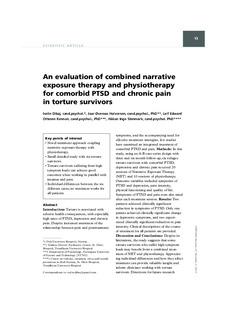An evaluation of combined narrative exposure therapy and physiotherapy for comorbid PTSD and chronic pain in torture survivors
Journal article, Peer reviewed
Published version
Permanent lenke
http://hdl.handle.net/11250/2496649Utgivelsesdato
2017Metadata
Vis full innførselSamlinger
- Institutt for psykologi [3103]
- Publikasjoner fra CRIStin - NTNU [38127]
Originalversjon
Journal on Rehabilitation of Torture Victims and Prevention of Torture. 2017, 27 (1), 13-27.Sammendrag
INTRODUCTION:
Torture is associated with adverse health consequences, with especially high rates of PTSD, depression and chronic pain. Despite increased awareness of the relationship between pain and posttraumaticsymptoms, and the accompanying need for effective treatment strategies, few studies have examined an integrated treatment of comorbid PTSD and pain.
METHODS:
In this study, using an A-B case series design with three and six month follow-up, six refugee torture survivors with comorbid PTSD, depression and chronic pain received 20 sessions of Narrative Exposure Therapy (NET) and 10 sessions of physiotherapy. Outcome variables included symptoms of PTSD and depression, pain intensity, physical functioning and quality of life. Symptoms of PTSD and pain were also rated after each treatment session.
RESULTS:
Two patients achieved clinically significant reduction in symptoms of PTSD. Only one patient achieved clinically significant change in depressive symptoms, and two experienced clinically significant reduction in pain intensity. Clinical descriptions of the course of treatment for all patients are provided.
DISCUSSION AND CONCLUSIONS:
Despite its limitations, the study suggests that some torture survivors who suffer high symptom loads may benefit from a combined treatment of NET and physiotherapy. Appreciating individual differences and how they affect treatment can provide valuable insight and inform clinicians working with torture survivors. Directions for future researchregarding the improvement of rehabilitation strategies of torture survivors are discussed, and highlighted through descriptions from the six therapy cases.
